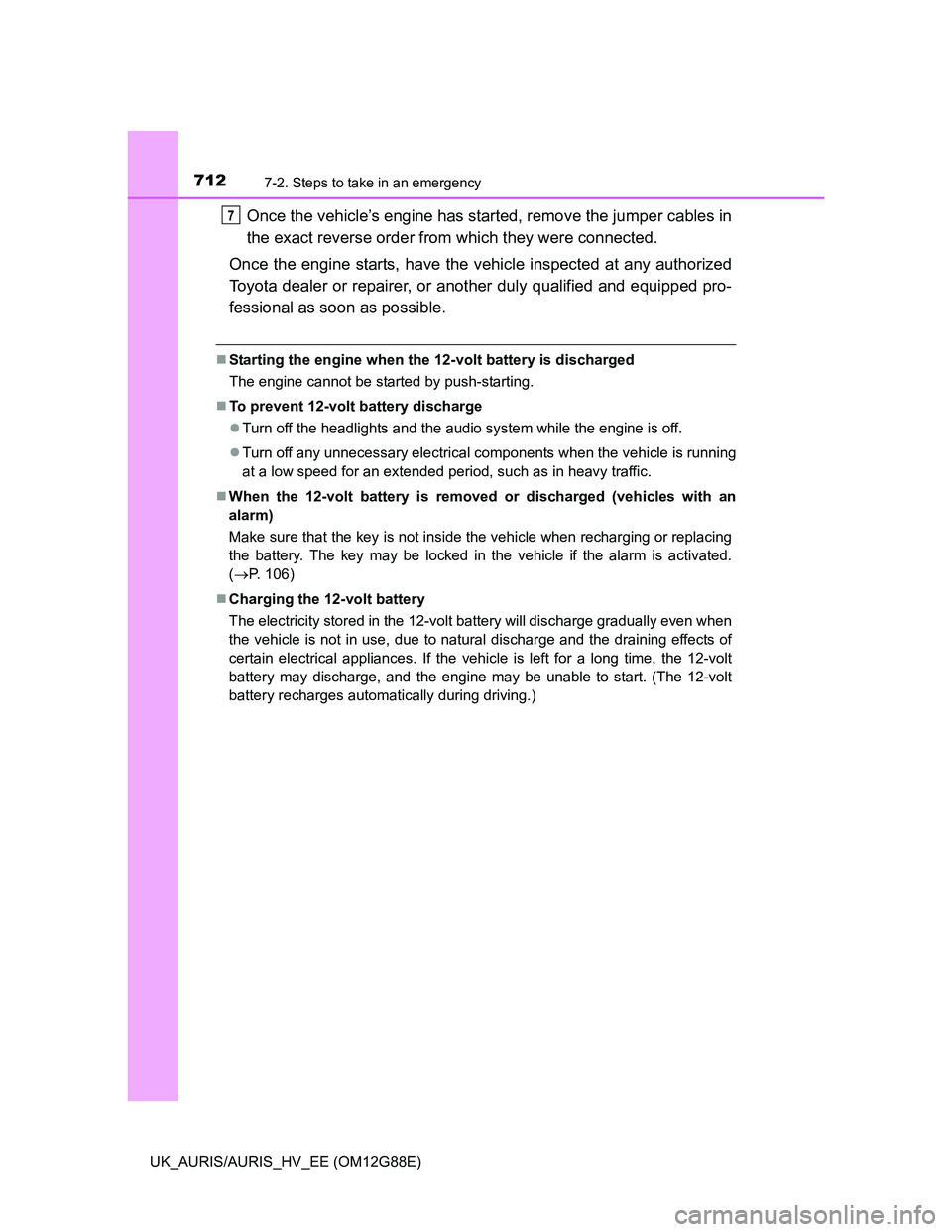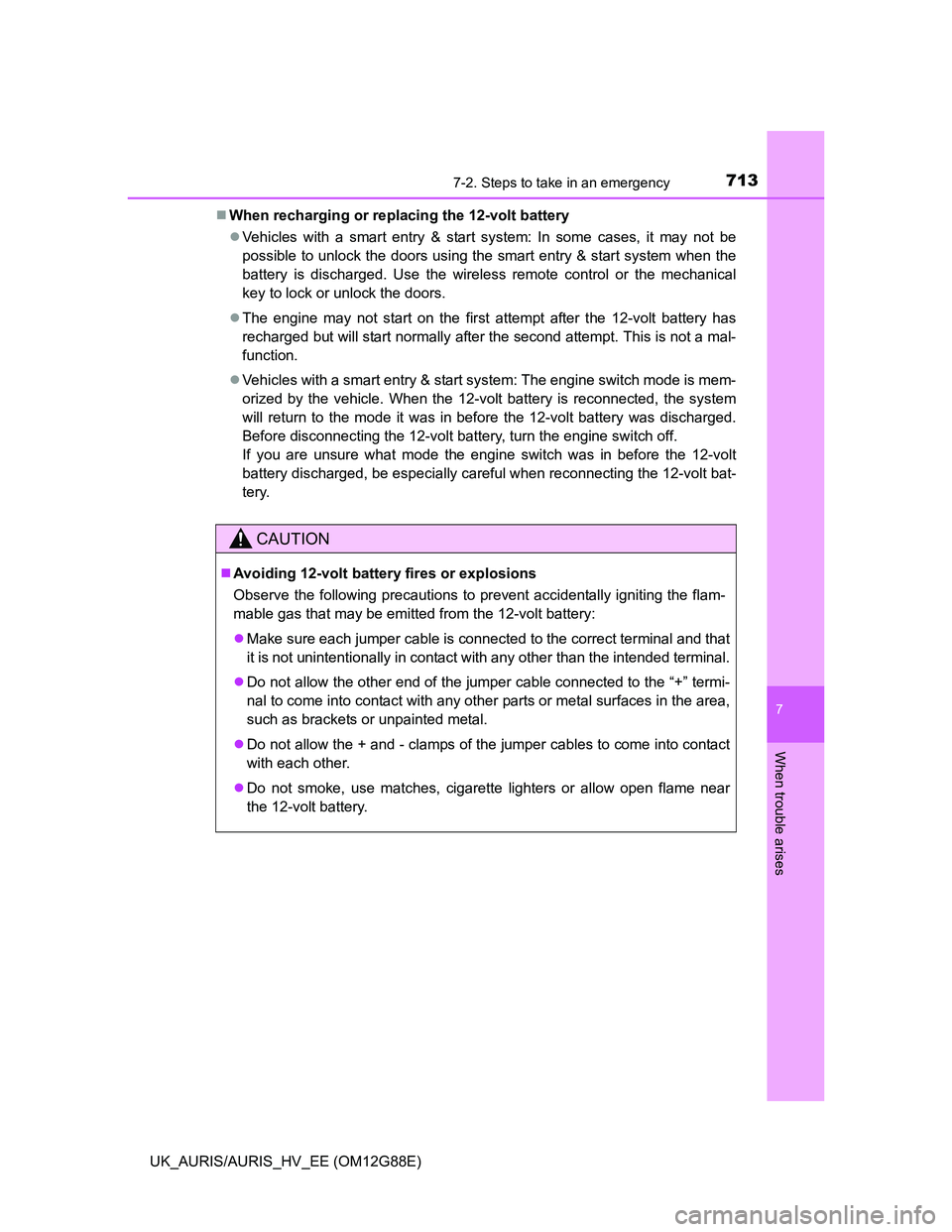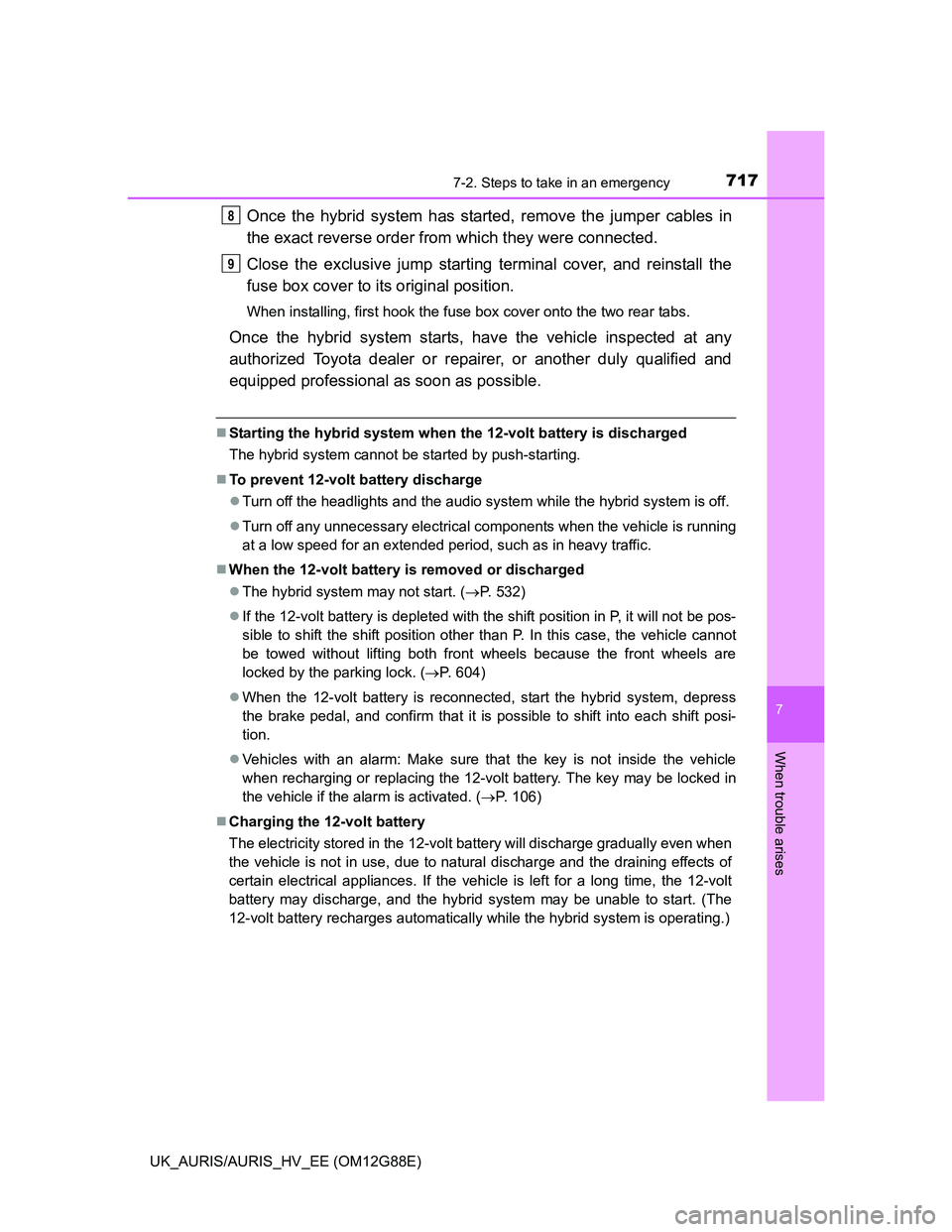Page 702 of 788
7027-2. Steps to take in an emergency
UK_AURIS/AURIS_HV_EE (OM12G88E)
Set the parking brake.
Vehicles without a smart entry & start system: Turn the engine
switch to the “ACC” position.
Vehicles with a smart entry & start system: Turn the engine switch
to ACCESSORY mode.
Depress the brake pedal.
Press the shift lock override
button.
The shift lever can be shifted while
the button is pressed.
If the shift lever cannot be shifted from P
(vehicles with a Multidrive)
If the shift lever cannot be shifted with your foot on the brake
pedal, there may be a problem with the shift lock system (a sys-
tem to prevent accidental operation of the shift lever). Have the
vehicle inspected by any authorized Toyota dealer or repairer, or
another duly qualified and equipped professional immediately.
The following steps may be used as an emergency measure to
ensure that the shift lever can be shifted:
1
2
3
4
Page 703 of 788
7037-2. Steps to take in an emergency
UK_AURIS/AURIS_HV_EE (OM12G88E)
7
When trouble arises
Set the parking brake.
Start the engine.
Depress the brake pedal.
Press the shift lock override
button with a flathead screw-
driver or equivalent.
The shift lever can be shifted while
the button is pressed.
If the shift lever cannot be shifted (vehicles
with a multi-mode manual transmission)
If the shift lever cannot be shifted with your foot on the brake,
there may be a problem with the shift lock system (a system to
prevent accidental operation of the shift lever). Have the vehicle
inspected by any authorized Toyota dealer or repairer, or
another duly qualified and equipped professional, immediately.
The following steps may be used as an emergency measure to
ensure that the shift lever can be shifted.
1
2
3
4
Page 704 of 788
7047-2. Steps to take in an emergency
UK_AURIS/AURIS_HV_EE (OM12G88E)
Use the mechanical key
(P. 155) in order to perform the
following operations:
Locks all the doors
Unlocks all the doors
If the electronic key does not operate properly (vehicles
with a smart entr y & start system or push button start)
If communication between the electronic key and vehicle is
interrupted (P. 164) or the electronic key cannot be used
because the battery is depleted, the smart entry & start system,
push button start and wireless remote control cannot be used. In
such cases, the doors can be opened and the engine can be
started by following the procedure below.
Locking and unlocking the doors
1
2
Page 706 of 788

7067-2. Steps to take in an emergency
UK_AURIS/AURIS_HV_EE (OM12G88E)
Depress the brake pedal.
Touch the Toyota emblem side
of the electronic key to the
power switch.
When the electronic key is
detected, a buzzer sounds and the
power switch will turn to ON mode.
When the smart entry & start sys-
tem or push button start is deacti-
vated in customization setting, the
power switch will turn to ACCES-
SORY mode.
Firmly depress the brake pedal and check that is shown on
the multi-information display.
Press the power switch.
In the event that the hybrid system still cannot be started, contact any
authorized Toyota dealer or repairer, or another duly qualified and
equipped professional.
Stopping the engine (except hybrid model)
Shift the shift lever to P (Multidrive) or N (manual transmission and multi-
mode manual transmission) and press the engine switch as you normally do
when stopping the engine.
Stopping the hybrid system (hybrid model)
Shift the shift position to P and press the power switch as you normally do
when stopping the hybrid system.
Replacing the key battery
As the above procedure is a temporary measure, it is recommended that the
electronic key battery be replaced immediately when the battery is depleted.
(P. 555)
Alarm (if equipped)
Using the mechanical key to lock the doors will not set the alarm system.
If a door is unlocked using the mechanical key when the alarm system is set,
the alarm may be triggered.
Starting the hybrid system (hybrid model)
1
2
3
4
Page 712 of 788

7127-2. Steps to take in an emergency
UK_AURIS/AURIS_HV_EE (OM12G88E)
Once the vehicle’s engine has started, remove the jumper cables in
the exact reverse order from which they were connected.
Once the engine starts, have the vehicle inspected at any authorized
Toyota dealer or repairer, or another duly qualified and equipped pro-
fessional as soon as possible.
Starting the engine when the 12-volt battery is discharged
The engine cannot be started by push-starting.
To prevent 12-volt battery discharge
Turn off the headlights and the audio system while the engine is off.
Turn off any unnecessary electrical components when the vehicle is running
at a low speed for an extended period, such as in heavy traffic.
When the 12-volt battery is removed or discharged (vehicles with an
alarm)
Make sure that the key is not inside the vehicle when recharging or replacing
the battery. The key may be locked in the vehicle if the alarm is activated.
(P. 106)
Charging the 12-volt battery
The electricity stored in the 12-volt battery will discharge gradually even when
the vehicle is not in use, due to natural discharge and the draining effects of
certain electrical appliances. If the vehicle is left for a long time, the 12-volt
battery may discharge, and the engine may be unable to start. (The 12-volt
battery recharges automatically during driving.)
7
Page 713 of 788

7137-2. Steps to take in an emergency
UK_AURIS/AURIS_HV_EE (OM12G88E)
7
When trouble arises
When recharging or replacing the 12-volt battery
Vehicles with a smart entry & start system: In some cases, it may not be
possible to unlock the doors using the smart entry & start system when the
battery is discharged. Use the wireless remote control or the mechanical
key to lock or unlock the doors.
The engine may not start on the first attempt after the 12-volt battery has
recharged but will start normally after the second attempt. This is not a mal-
function.
Vehicles with a smart entry & start system: The engine switch mode is mem-
orized by the vehicle. When the 12-volt battery is reconnected, the system
will return to the mode it was in before the 12-volt battery was discharged.
Before disconnecting the 12-volt battery, turn the engine switch off.
If you are unsure what mode the engine switch was in before the 12-volt
battery discharged, be especially careful when reconnecting the 12-volt bat-
tery.
CAUTION
Avoiding 12-volt battery fires or explosions
Observe the following precautions to prevent accidentally igniting the flam-
mable gas that may be emitted from the 12-volt battery:
Make sure each jumper cable is connected to the correct terminal and that
it is not unintentionally in contact with any other than the intended terminal.
Do not allow the other end of the jumper cable connected to the “+” termi-
nal to come into contact with any other parts or metal surfaces in the area,
such as brackets or unpainted metal.
Do not allow the + and - clamps of the jumper cables to come into contact
with each other.
Do not smoke, use matches, cigarette lighters or allow open flame near
the 12-volt battery.
Page 715 of 788
7157-2. Steps to take in an emergency
UK_AURIS/AURIS_HV_EE (OM12G88E)
7
When trouble arises
If you have a set of jumper (or booster) cables and a second vehicle
with a 12-volt battery, you can jump start your vehicle by following the
steps below.
Open the hood and fuse block
cover.
Open the exclusive jump start-
ing terminal cover.
If the 12-volt batter y is discharged (hybrid
model)
The following procedures may be used to start the hybrid sys-
tem if the 12-volt battery is discharged.
You can also call any authorized Toyota dealer or repairer, or
another duly qualified and equipped professional.
1
2
Page 717 of 788

7177-2. Steps to take in an emergency
UK_AURIS/AURIS_HV_EE (OM12G88E)
7
When trouble arises
Once the hybrid system has started, remove the jumper cables in
the exact reverse order from which they were connected.
Close the exclusive jump starting terminal cover, and reinstall the
fuse box cover to its original position.
When installing, first hook the fuse box cover onto the two rear tabs.
Once the hybrid system starts, have the vehicle inspected at any
authorized Toyota dealer or repairer, or another duly qualified and
equipped professional as soon as possible.
Starting the hybrid system when the 12-volt battery is discharged
The hybrid system cannot be started by push-starting.
To prevent 12-volt battery discharge
Turn off the headlights and the audio system while the hybrid system is off.
Turn off any unnecessary electrical components when the vehicle is running
at a low speed for an extended period, such as in heavy traffic.
When the 12-volt battery is removed or discharged
The hybrid system may not start. (P. 532)
If the 12-volt battery is depleted with the shift position in P, it will not be pos-
sible to shift the shift position other than P. In this case, the vehicle cannot
be towed without lifting both front wheels because the front wheels are
locked by the parking lock. (P. 604)
When the 12-volt battery is reconnected, start the hybrid system, depress
the brake pedal, and confirm that it is possible to shift into each shift posi-
tion.
Vehicles with an alarm: Make sure that the key is not inside the vehicle
when recharging or replacing the 12-volt battery. The key may be locked in
the vehicle if the alarm is activated. (P. 106)
Charging the 12-volt battery
The electricity stored in the 12-volt battery will discharge gradually even when
the vehicle is not in use, due to natural discharge and the draining effects of
certain electrical appliances. If the vehicle is left for a long time, the 12-volt
battery may discharge, and the hybrid system may be unable to start. (The
12-volt battery recharges automatically while the hybrid system is operating.)
8
9